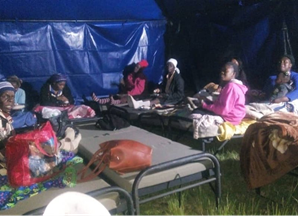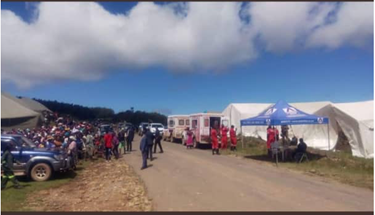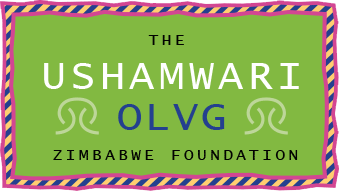Mutare region hit by cyclone; report from Dr. David Mucharewese


Good morning. Thank you. The areas which are greatly affected are chimanimani and Chipinge which are districts to the south east of Mutare. we have many families which are affected many have been left homeless and school children have also been affected and this includes one of the Catholic school St Charles Lwanga. The patients who are been seen presently are attended to at the makeshift centres In Skyline and Birchnough bridge. these are close to the site where the cyclone affected the most. Several patients have been attended to and these mainly required surgery for fractures and septic wounds. One mother was also evacuated as she was in labour with 2 previous C/section. Most patients have been send to the provincial hospital in Mutare but our hosp have been put on standby for possible transfer of stable patients from the Provincial hospital. I shall forward a report we received from one of the Drs who went into the field yesterday I apologize for not communicating at all since yesterday. It is because my mobile phone keypad became unusable as we travelled to Chipinge.
Now, that said, I managed to join a PMD team that travelled to the Skyline. I must thank Dr Mkuzunga for making this possible.
The team comprised of the DEHO, PNO, Nutritionist, accountant, a Partner Rep and the Driver.
We had to drive through to Skyline via Chipinge because the more direct route through Mutambara is not now accessible by road.
about 8 km from Chiredzi turn off there is a detour where we were stopped briefly as the new gravel road was being fixed.
The effects of the cyclone became more and more evident as we approached Jopa area (the chimanimani turn off) as one could see rockfall paths created in the mountain slopes and rubble created by the floods along the road we drove through. The road link to Skyline from Jopa is replete with land slides and rockfalls but thankfully some graders are in place to clear the rubble.
One are in the mountains deserves special mention. A large gully was created and has menacingly approached the road . Some very polite security details are stationed there to direct traffic and one shudders to think what will happen if more rains were to fall in this area. Only light vehicles are being allowed beyond this and I should say only those with adequate clearance (and I think only 4x4s) can navigate through. This is because some knee high mud was created by some land slide there.
We got to the camp at about 1430
Some tents had already been pitched and that place was buzzing with anxious human faces ( locals, newsmen, cameramen, medical and other relief staff) We noted helicopters had already started flying in the camp the injured from the Chimanimani valley. Ground ambulances were ferrying in patients to Chipinge Hospital. We were told at a briefing that the severely injured were the first to be evacuated and as such all subsequent heli trips flew in more stable patients; mainly those with broken limbs and some with bad soft tissue injuries.
The Chipinge district CPU is overall in charge and our point person was the DMO.
A further briefing for clinical staff highlighted the following:
A group of young doctors mainly from Harare were the first health related team to get to the camp earlier in the day
5 were airlifted to areas in the valley where patients had been housed in churches and or schools.
3 doctors remained at the camp to receive , triage, stabilise and put patients on ambulances to Chipinge Hospital.
MSF also had a very visible functional team that appeared very well versed with dealing with a situation of this kind and magnitude.
As time went by doctors from various organizations started to arrive too, notably Red Creasant Zimbabwe, Who, UN agencies, PSMAS, Emras etc.
The plan by end of day by the health team was to establish a functional emergency treatment centre, with water, sanitation and hygiene as priority items. Food and medical supplies needed to be procured and put in place as well.
No supplies quantification was possible yet as most planning was being done as rescue and attention to the injured was on going.
It was encouraged that clinical personnel not be discouraged from joining the team there but that they be organised into a roster system to avoid burn out on those already on the ground. All specialties were encouraged to be there at the receiving camp while others were advised to direct their interventions at the referral hospitals that were taking in patients from the camp.
Just to mention that a mother with 2 previous C/s in labour had to be airlifted to Chipinge as well in the day. Am ambulance was waiting for a mother that was reported to be bleeding post abortion. Local community patients also presented with various ailments after learning there was medical personnel on the ground.
3 doctors stayed at the camp overnight. The situation was expected to remain quiet given that helicopters were not going to be working overnight.
One needs to carry toiletries, drinking water, food, beverages, powerbank, raincoat, torch a sleeping bag among other personal effects.
So the situation as at 6 o’clock last night remained dire as the road to Ngangu and Chimanimani hotel is completely impassable and unconfirmed verbal reports mentioned worse things could be brewing in the Rusitu valley.
We got back to Mutare at any 2200hs.
